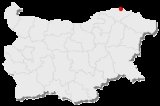
Aydemir
Encyclopedia

Bulgaria
Bulgaria , officially the Republic of Bulgaria , is a parliamentary democracy within a unitary constitutional republic in Southeast Europe. The country borders Romania to the north, Serbia and Macedonia to the west, Greece and Turkey to the south, as well as the Black Sea to the east...
, part of Silistra Municipality
Silistra Municipality
Silistra Municipality is a municipality in Silistra Province, Northeastern Bulgaria, located along the right bank of Danube river, in the Danubian Plain, bounded by Romania to the northeast and north beyond the river...
, Silistra Province
Silistra Province
Silistra Province is a province of Bulgaria, named after its main city - Silistra. It is divided into 7 municipalities with a total population, as of December 2009, of 127,659 inhabitants....
. As of 2007, it is the most populous village in Bulgaria, with a population of 7,815 according to 2005 data. Aydemir lies at 44°6′N 27°10′E, 31 m above sea level. The village is located in the valley of the Danube
Danube
The Danube is a river in the Central Europe and the Europe's second longest river after the Volga. It is classified as an international waterway....
, 3 km south of the river and 8 km west of Silistra, on the road from Silistra to Rousse
Rousse
Ruse is the fifth-largest city in Bulgaria. Ruse is situated in the northeastern part of the country, on the right bank of the Danube, opposite the Romanian city of Giurgiu, from the capital Sofia and from the Bulgarian Black Sea Coast...
. The mayor is Rumen Angelov.
Aydemir is divided into three parts: the centre, the quarter of Delenkite and the quarter of Tataritsa, which was founded in 1674 by Old Believer Nekrasov Cossacks
Nekrasov Cossacks
Nekrasov Cossacks, Nekrasovite Cossacks, Nekrasovites, Nekrasovtsy are descendants of Don Cossacks which, after the defeat of the Bulavin Rebellion fled to the Kuban , headed by Ignat Nekrasov, hence the name. The Kuban was then under the rule of the Crimean Khanate...
(see Russians in Bulgaria
Russians in Bulgaria
Russians form the fourth largest ethnic group in Bulgaria, numbering 9,978 according to the 2011 census, and mostly living in the large urban centres, such as Sofia, Plovdiv, Varna and Burgas...
) at a location prior to that inhabited by Tatars
Tatars
Tatars are a Turkic speaking ethnic group , numbering roughly 7 million.The majority of Tatars live in the Russian Federation, with a population of around 5.5 million, about 2 million of which in the republic of Tatarstan.Significant minority populations are found in Uzbekistan, Kazakhstan,...
.
The village has a church, the Church of the Holy Trinity, which was constructed in 1829. For a certain period, it was named Knyaz Hesenski (Княз Хесенски, "Grand Duke of Hesse
Rulers of Hesse
This is a list of rulers of Hesse during the history of Hesse on west-central Germany. These rulers belonged to a dynasty collectively known as the House of Hesse and the House of Brabant, originally the Reginar...
") in honour of Alexander I Battenberg
Alexander, Prince of Bulgaria
Alexander Joseph, Prince of Bulgaria GCB , known as Alexander of Battenberg, was the first prince of modern Bulgaria, reigning from 29 April 1879 to 7 September 1886.-Early life:...
, the first monarch of modern Bulgaria.
According to Ancho Kaloyanov, the name of the village is derived from Greek
Greek language
Greek is an independent branch of the Indo-European family of languages. Native to the southern Balkans, it has the longest documented history of any Indo-European language, spanning 34 centuries of written records. Its writing system has been the Greek alphabet for the majority of its history;...
άγιος (agios, "Saint
Saint
A saint is a holy person. In various religions, saints are people who are believed to have exceptional holiness.In Christian usage, "saint" refers to any believer who is "in Christ", and in whom Christ dwells, whether in heaven or in earth...
") and the shortening of the personal name Demetrius
Demetrius
Demetrius, also spelled as Demetrios, Dimitrios, Demitri, and Dimitri , is a male given name.Demetrius and its variations may refer to the following:...
, i.e. "Saint Demetrius", both through Turkic
Turkic languages
The Turkic languages constitute a language family of at least thirty five languages, spoken by Turkic peoples across a vast area from Eastern Europe and the Mediterranean to Siberia and Western China, and are considered to be part of the proposed Altaic language family.Turkic languages are spoken...
.
In 1924, a 14th-century treasure comprising 101 silver coins, including some of Tsar Ivan Alexander of Bulgaria
Ivan Alexander of Bulgaria
Ivan Alexander , also known as John Alexander, ruled as Emperor of Bulgaria from 1331 to 1371, during the Second Bulgarian Empire. The date of his birth is unknown. He died on February 17, 1371. The long reign of Ivan Alexander is considered a transitional period in Bulgarian medieval history...
, was discovered near the village.

